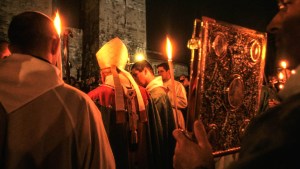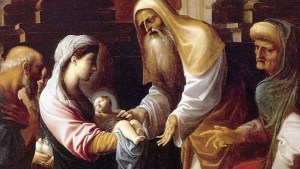Lenten Campaign 2025
This content is free of charge, as are all our articles.
Support us with a donation that is tax-deductible and enable us to continue to reach millions of readers.
The Gospel of Luke speaks about an elderly woman, Anna, in reference to the Presentation of Jesus at the Temple, and gives us a number of details regarding her identity.
The Roman Martyrology lists 68 saints celebrated on September 1. This includes two groups of martyrs, as well as men and women saints from different time periods. It also includes Anna, the Prophetess.
She is a prophetess, who “never left the temple, but worshiped night and day with fasting and prayer” (Lk 2:37). Anna was married for seven years and, at the time of the Presentation in the Temple, “was a widow of 84 years.”
This has been interpreted by many to mean that she was 84 years of age when she met Jesus in the Temple. Others, including St. Ambrose of Milan, believe that she had been a widow for 84 years; assuming she had married at the typical age of the time, this would make her around 105 years old when meeting the Lord.
Perhaps the most intriguing, and somewhat mysterious information the Gospel gives us about Anna is that she comes from one of the lost tribes of Israel, the house of Asher.

Read more:
What you need to know about the beautiful feast of Candlemas
After the reign of Solomon, in the 10th century BC, the Jewish nation divided into two kingdoms. The southern Kingdom of Judah, which contained Jerusalem, was comprised of the tribes of Judah and Benjamin.
The Northern Kingdom kept the name Israel, and was occupied by the tribes of Asher, Dan, Ephraim, Gad, Issachar, Manasseh, Naphtali, Reuben, Simeon and Zebulun.
The tribe of Levi, which preserved the priesthood of Israel, never owned land, and therefore isn’t listed among the tribes of either kingdom, but was primarily associated with Jerusalem, the center of worship.
The Assyrians conquered the northern Kingdom of Israel in the 8th century BC, and expelled the 10 tribes. This is where recorded history ends and legend begins.
Stuck in exile
According to rabbinic literature, the Assyrians had expelled the tribes beyond a certain river, the Sambation (also spelled Sambatyon). This river was impassable six days of the week and only calm on the Sabbath when, according to their religious norms, the Jews were unable to work or travel; the 10 tribes were therefore stuck in exile, unable to rejoin the southern kingdom.
Some believe that, in reality, a great number of the “lost tribes” ended up rejoining the rest of the Israelites or mixed in with the Samarians, and therefore no longer exist as distinct peoples. Others, however, believe that the lost tribes could explain the origin and ancestry of multiple groups, including indigenous Americans, the Pashtuns, the Nestorians, the Afghans and the Japanese. All these hypotheses lie in the realm of what cannot be definitively proven, but is difficult to disprove, hence allowing for continued speculation and opinions.
But without knowing what exactly happened to the lost tribes after the exile, we do know that at least some of them made their way back to Israel. Anna, a member of the tribe of Asher, was praying, fasting and worshiping there in the Temple.
Reunited in Christ
It’s no coincidence that Anna was in the Temple the day of the Lord’s presentation. Nor is it coincidence that the evangelist not only named her, but specified that she was a descendent of Asher. The prophet Simeon is believed to have been either one of the temple priests, and therefore from the tribe of Levi, or Simeon ben Hillel, son of Hillel the Elder, from the tribe of Benjamin.
St. Luke thus presents the Presentation as a moment of wholeness of the Jewish people, in which the Messiah is received and recognized by both sides of the divide that had occurred centuries before.
In times when the pain of division, misunderstanding, and confusion seem so widespread, she is a reminder to us that hope, healing, and reconciliation are possible.
St. Anna the Prophetess, pray for us.

Read more:
Why the 4th Joyful Mystery is joyful only because Mary is Mary

